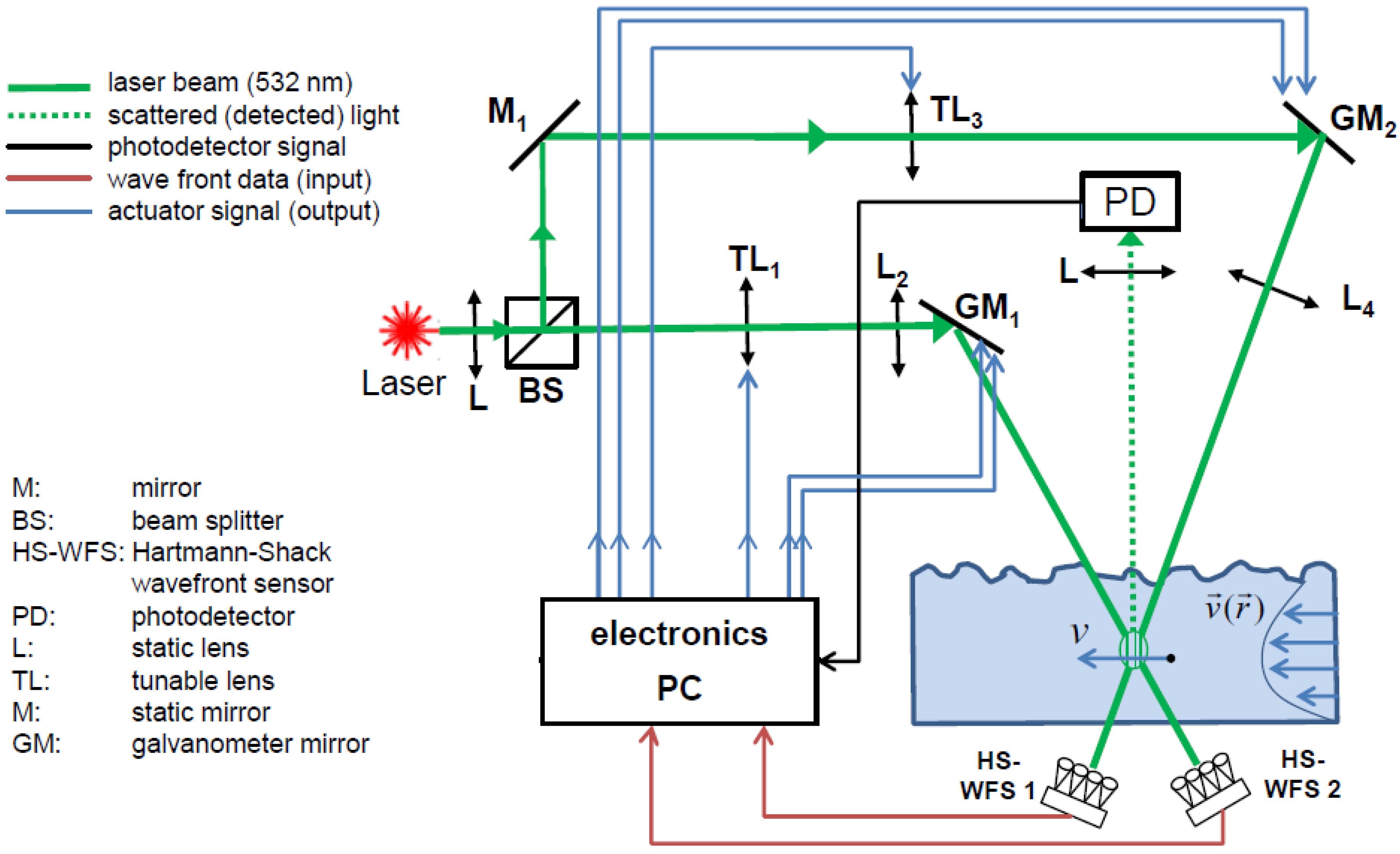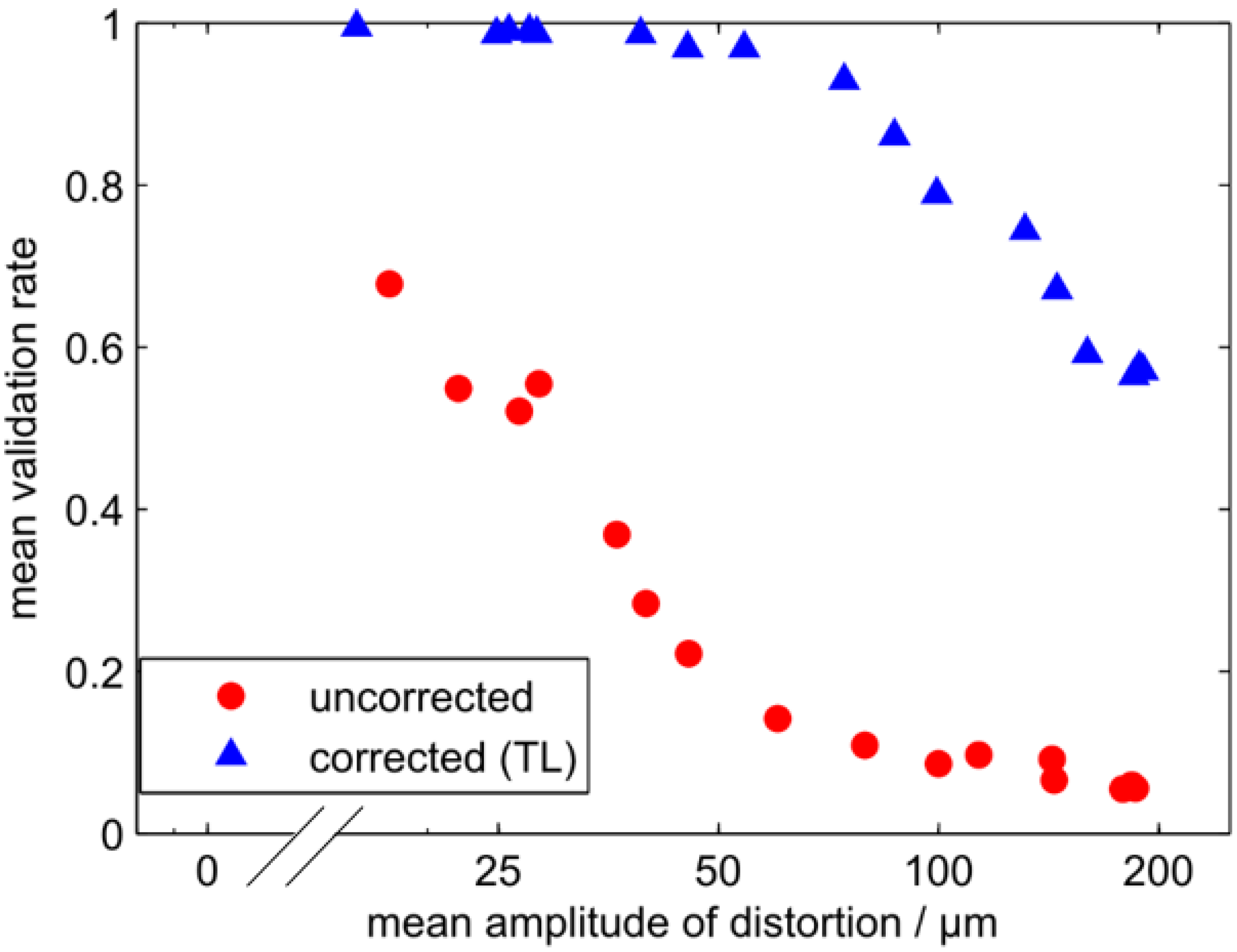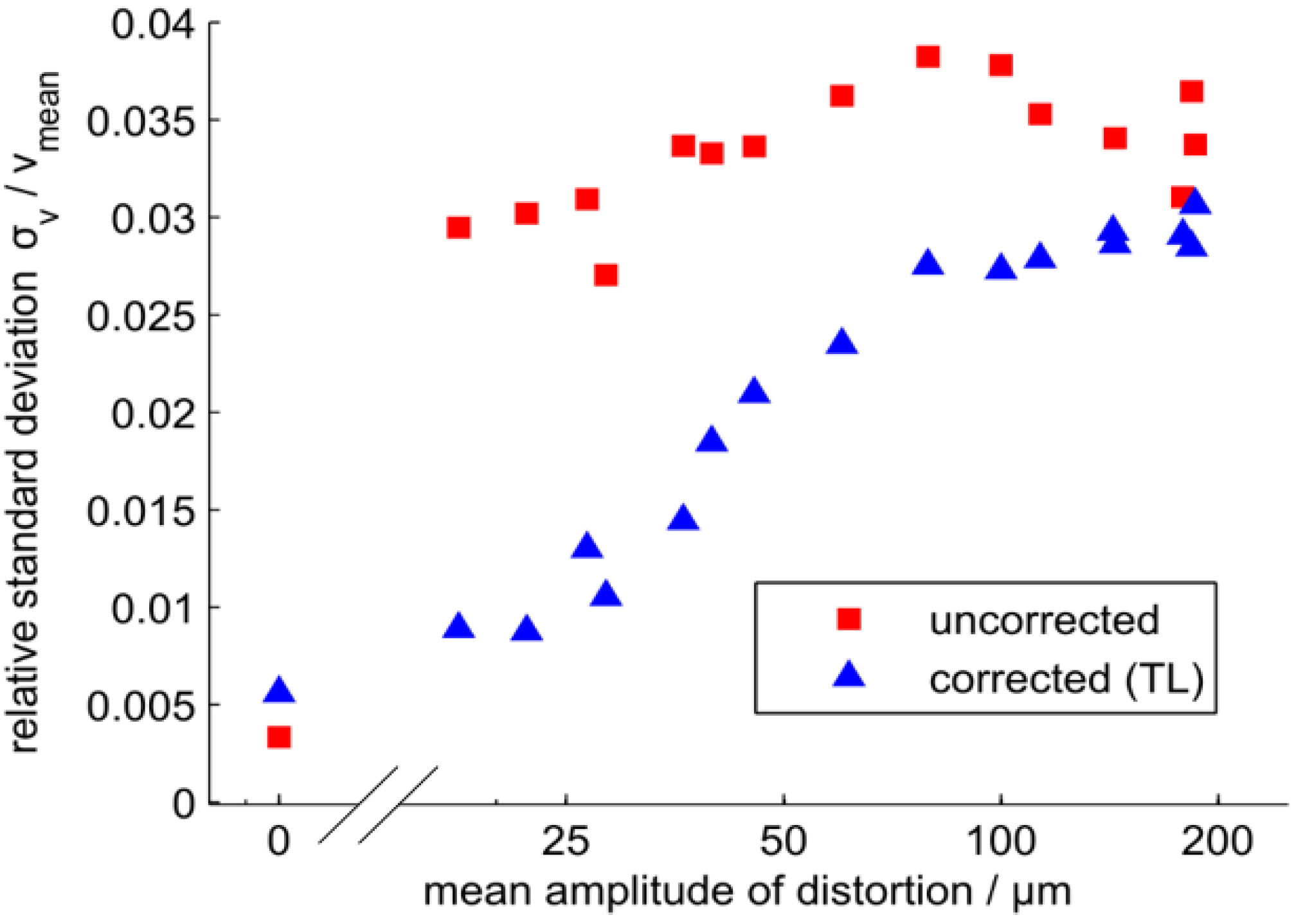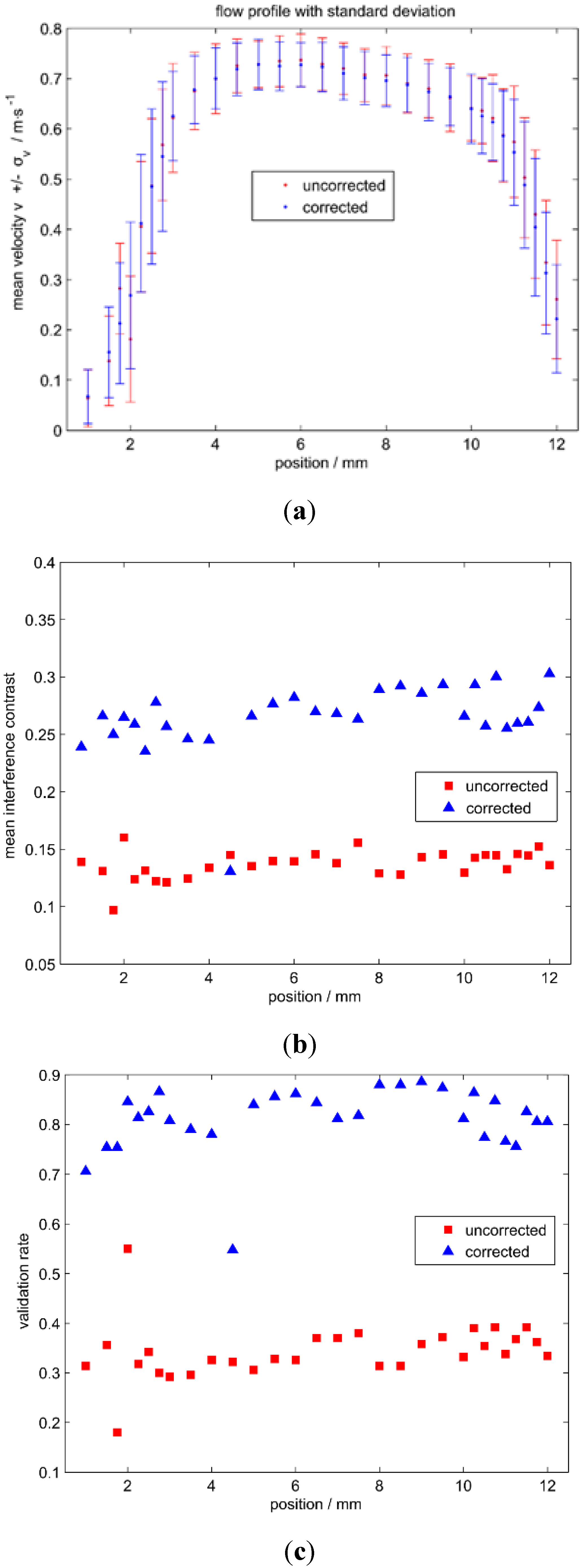Smart Laser Interferometer with Electrically Tunable Lenses for Flow Velocity Measurements through Disturbing Interfaces
Abstract
:1. Motivation
2. Velocity Measurements through a Fluctuating Gas-Liquid Interface
2.1. Preconsiderations
- 0th order: Height or stroke of the air-water interface. For a lift of the interface a parallel shift of the beam occurs whereas the beam direction remains constant. The consequence is a shift of the position of the measurement volume, i.e., a dislocation of the measurement position. Furthermore a signal frequency jitter is introduced, if a stochastic fluctuation of the air-water interface occurs.
- 1st order: Tilt of the air-water interface. Due to refraction, a tilt of the interface will change the propagation direction of the laser beam. Going to the two-dimensional consideration, it has to be distinguished between a tilt in the plane spanned by the two partial beams δx and a tilt in the direction normal to this plane δy.
- (a)
- Tilt δx in x-direction (tip): On one side a displacement of the measurement position results and on the other side there is a change in the intersection half angle θ of the interfering laser beams. Due to a change of the Rayleigh length zR or the beam waist position zw a variation of interference fringe spacing d results, see Equation (2). The standard deviation σd represents these variations. Using Equation (1) and the propagation law of statistical independent measurement, uncertainties of the fringe spacing σd and the signal frequency σf the relative velocity measurement uncertainty yields to [13]
- (b)
- Tilt δy in y-direction: A beam deflection in the y-direction normal to the plane spanned by the two Gaussian beams will result in skew rays. The reduced overlap of the partial laser beams results in lower interference visibility and signal-to-noise ratio (SNR). Only measurement signals with a sufficient SNR are considered for further evaluation. The corresponding validation rate is given by the ratio between the evaluable and all signals detected. It represents a crucial figure-of-merit of the LDV system, since on the one hand the maximum frequency bandwidth of the velocity fluctuations and on the other the effective measurement time is determined. In the worst case of negligible laser beam overlapping no measurements can be performed at all, represented by a validation rate of zero.
- 2nd order: Parabolic curvature of the interface. Due to refraction, a curvature of the interface induces a lens effect on the beam propagation. It changes the radius of the beam waist w0 and the position zW of the beam waist. As a consequence, the fringe spacing d is changed according to Equation (2), which in general enhances the velocity measurement uncertainty, see Equation (4).
- 3nd order and higher orders: Distortions of the surface with high spatial frequency. The wavefront of the laser beams will be locally distorted, leading to inhomogeneities in the interference fringes. The fringe spacing can vary in all three directions. In consequence, the measurement uncertainty will increase, see Equation (4).
2.2. Smart Laser Interferometer with Electrically Tunable Lenses
- A high defocus range of up to ±40 diopters can be covered.
- A 3 dB temporal bandwidth of over 60 Hz. It should be high enough to correct the distortions of the capillary waves at the current experiment.
- Due to its outer size of 20 mm diameter the tunable lens is ideal for being integrated into compact sensors.
- The focal lengths of the tunable lens for the first and second partial beams
- The deflections of the mirror in x-direction for the first and second partial beams
- The deflections of the mirror in y-direction for the first and second partial beams

2.3. Performance of the Distortion Correction


2.4. Flow Velocity Measurements


3. Conclusions
Acknowledgments
Author Contributions
Conflicts of Interest
References
- Birch, K.P.; Downs, M.J. An Updated Edlén Equation for the Refractive Index of Air. Metrologia 1993, 30, 155–162. [Google Scholar] [CrossRef]
- Beckers, J.M. Adaptive Optics for Astronomy: Principles, Performance, and Applications. Ann. Rev. Astron. Astrophys. 1993, 31, 13–62. [Google Scholar] [CrossRef]
- Hardy, J.W. Adaptive Optics for Astronomical Telescopes; Oxford University Press: New York, NY, USA, 1998. [Google Scholar]
- Glindemann, A.; Hippler, S.; Berkefeld, T.; Hackenberg, W. Adaptive Optics on Large Telescopes. Exp. Astron. 2000, 10, 5–47. [Google Scholar] [CrossRef]
- Tyson, R. Principles of Adaptive Optics, Third Edition; CRC Press: Boca Raton, FL, USA, 2010. [Google Scholar]
- Roorda, A.; Romero-Borja, F.W.D., III; Queener, H.; Hebert, T.; Campbell, M. Adaptive optics scanning laser ophthalmoscopy. Opt. Express 2002, 10, 405–412. [Google Scholar] [CrossRef] [PubMed]
- Hermann, B.; Fernández, E.J.; Unterhuber, A.; Sattmann, H.; Fercher, A.F.; Drexler, W.; Prieto, P.M.; Artal, P. Adaptive-optics ultrahigh-resolution optical coherence tomography. Opt. Lett. 2004, 29, 2142–2144. [Google Scholar] [CrossRef] [PubMed]
- Fuh, Y.K.; Hsu, K.C.; Fan, J.R. Rapid in-process measurement of surface roughness using adaptive optics. Opt. Lett. 2012, 37, 848–850. [Google Scholar] [CrossRef] [PubMed]
- Fuh, Y.K.; Fan, J.R. Experimental investigation of a flowing fluid layer on metal surface roughness measurement and aberration correction using adaptive optics. Opt. Rev. 2013, 20, 433–437. [Google Scholar] [CrossRef]
- Klepikov, K.E.; Kulybin, V.M.; Rinkevichius, B.S. Using the principles of adaptive optics in laser Doppler anemometry. In Proceedings of the Vsesoiuznyi Seminar po Opticheskim Metodam Issledovaniia Potokov 1st, Novosibirsk, USSR, 23–25 May 1989. (In Russian)
- Büttner, L.; Leithold, C.; Czarske, J. Advancement of an Interferometric Flow Velocity Measurement Technique by Adaptive Optics. Int. J. Optomech. 2014, 8, 1–13. [Google Scholar] [CrossRef]
- Büttner, L.; Leithold, C.; Czarske, J. Interferometric Velocity Measurements through a fluctuating Gas-Liquid Interface Employing Adaptive Optics. Opt. Express 2013, 21, 30653–30663. [Google Scholar] [CrossRef] [PubMed]
- Czarske, J.; Büttner, L.; Razik, T.; Müller, H. Boundary layer velocity measurements by a laser Doppler profile sensor with micrometre spatial resolution. Measurement Sci. Technol. 2002, 13, 1979–1989. [Google Scholar] [CrossRef]
- Schneider, F.; Draheim, J.; Kamberger, R.; Waibel, P.; Wallrabe, U. Optical characterization of adaptive fluidic silicone-membrane lenses. Opt. Express 2009, 17, 11813–11821. [Google Scholar] [CrossRef] [PubMed]
- Khan, S.A.; Riza, N.A. Demonstration of a No-Moving-Parts Axial Scanning Confocal Microscope Using Liquid Crystal Optics. Opt. Commun. 2006, 265, 461–467. [Google Scholar] [CrossRef]
- Riza, N.A.; Sheikh, M.; Webb-Wood, G.; Kik, P.G. Demonstration of three-dimensional optical imaging using a confocal microscope based on a liquid-crystal electronic lens. Opt. Eng. J. 2008, 47, 063201:1–063201:9. [Google Scholar] [CrossRef]
- Koukourakis, N.; Finkeldey, M.; Stürmer, M.; Leithold, C.; Gerhardt, N.C.; Hofmann, M.R.; Wallrabe, U.; Czarske, J.W.; Fischer, A. Axial scanning in confocal microscopy employing adaptive lenses (CAL). Opt. Express 2014, 22, 6025–6039. [Google Scholar] [CrossRef] [PubMed]
- Fischer, A.; Schlüßler, R.; Haufe, D.; Czarske, J. Lock-in spectroscopy employing a high-speed camera and a micro-scanner for volumetric investigations of unsteady flows. Opt. Lett. 2014, 39, 5082–5085. [Google Scholar] [CrossRef] [PubMed]
- Fischer, A.; König, J.; Czarske, J.; Peterleithner, J.; Woisetschläger, J.; Leitgeb, T. Analysis of flow and density oscillations in a swirl-stabilized flame employing highly resolving optical measurement techniques. Exp. Fluids 2013. [Google Scholar] [CrossRef]
- Neumann, M.; Friedrich, C.; Kriegseis, J.; Grundmann, S.; Czarske, J. Determination of the phase-resolved body force produced by a dielectric barrier discharge plasma actuator. J. Phys. D 2013, 46, 042001. [Google Scholar] [CrossRef]
© 2015 by the authors; licensee MDPI, Basel, Switzerland. This article is an open access article distributed under the terms and conditions of the Creative Commons Attribution license (http://creativecommons.org/licenses/by/4.0/).
Share and Cite
Czarske, J.W.; Radner, H.; Leithold, C.; Büttner, L. Smart Laser Interferometer with Electrically Tunable Lenses for Flow Velocity Measurements through Disturbing Interfaces. Photonics 2015, 2, 1-12. https://doi.org/10.3390/photonics2010001
Czarske JW, Radner H, Leithold C, Büttner L. Smart Laser Interferometer with Electrically Tunable Lenses for Flow Velocity Measurements through Disturbing Interfaces. Photonics. 2015; 2(1):1-12. https://doi.org/10.3390/photonics2010001
Chicago/Turabian StyleCzarske, Jürgen W., Hannes Radner, Christoph Leithold, and Lars Büttner. 2015. "Smart Laser Interferometer with Electrically Tunable Lenses for Flow Velocity Measurements through Disturbing Interfaces" Photonics 2, no. 1: 1-12. https://doi.org/10.3390/photonics2010001
APA StyleCzarske, J. W., Radner, H., Leithold, C., & Büttner, L. (2015). Smart Laser Interferometer with Electrically Tunable Lenses for Flow Velocity Measurements through Disturbing Interfaces. Photonics, 2(1), 1-12. https://doi.org/10.3390/photonics2010001





